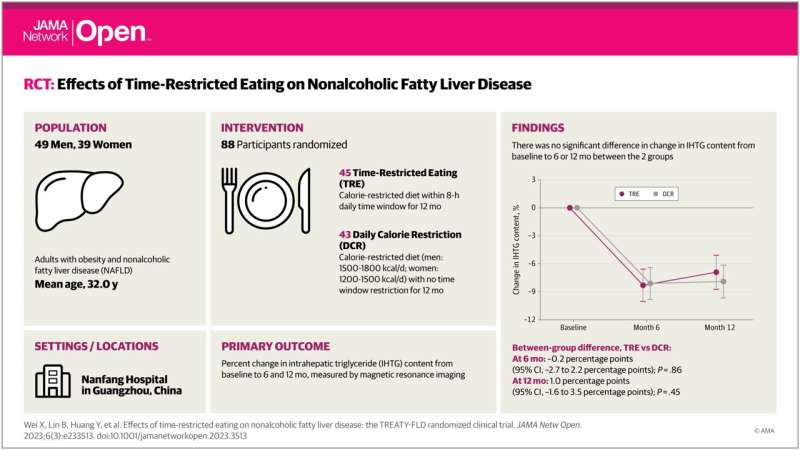
Adults with obesity and nonalcoholic fatty liver disease did not see additional reductions in intrahepatic triglyceride while on a time-restricted eating regimen compared to subjects on a daily calorie-restriction diet. This is according to a recent study published in the journal JAMA Network Open and led by researchers at Southern Medical University in Guangzhou, China and colleagues in the US at Tulane University School of Public Health and Tropical Medicine in New Orleans.
Nonalcoholic fatty liver disease (NAFLD) is when fat builds up in the liver. While some fat in the liver is normal, when more than 10% of a liver’s weight is fat there is a large increase in the correlated risk for metabolic disorders. There are currently no pharmaceutical solutions to prevent or reduce fatty liver buildup. However, weight loss and low-fat diets, in general, are known to lessen the condition by reducing inflammation and lessening available fats.
Time-restricted eating has been promoted as a potential alternative weight loss strategy to calorie reduction. While previous rat and observational studies in humans have linked time-restricted eating to weight loss, more significant health benefits are either untested or undertested in humans. The research group wanted to see if time-restricted eating could affect triglyceride content in obese patients with liver disease.
In the study “Effects of Time-Restricted Eating on Nonalcoholic Fatty Liver Disease,” 88 participants with obesity and NAFLD were randomly assigned to either the time-restricted or calorie-restricted diets. While both groups had to adhere to the same caloric energy intake, the time-restricted group was required to complete their intake between 8:00 am and 4:00 pm.
Intrahepatic triglyceride (IHTG) content was reduced in both groups, 8.3% in the time group and 8.1% in the calorie group at the end of 6 months. At the 12-month assessment, IHTG content was reduced by 6.9% in the time group and 7.9% in the calorie group. According to the report, secondary factors to the main study, liver stiffness, body weight, and metabolic risk factors, were significantly and comparably reduced in both groups.
Researchers in the current study conclude that time restriction alone does not show any additional health advantages and suggests that time restriction is no more effective than calorie restriction in body fat and visceral fat reduction among individuals with obesity.
More information:
Xueyun Wei et al, Effects of Time-Restricted Eating on Nonalcoholic Fatty Liver Disease, JAMA Network Open (2023). DOI: 10.1001/jamanetworkopen.2023.3513
Journal information:
JAMA Network Open
Source: Read Full Article